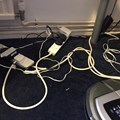Use our 'socket calculator'
Most people have multi-way extension leads in their homes, to increase the number of appliances that they can plug into a wall socket.
However, although there is space to plug in a number of appliances, this does not mean it is always safe to do so.
You can avoid overloading sockets and risk of fire by following this simple advice:
- Check the current rating of the extension lead before plugging appliances into it. Most are rated at 13 A, but some older versions may be rated at only 10 A or less - the rating should be clearly marked on the back or underside of the extension lead. If not, refer to the manufacturer’s instructions
- Never overload an extension lead by plugging in appliances that together will exceed the maximum current rating stated for the extension lead. This could cause the plug in the wall socket to overheat and possibly cause a fire.
- Use our overload calculator (below) to check if you’re exceeding the maximum load
- For an indication only of the current ratings of commonly-used domestic appliances - check out our information about Home Appliance Ratings.
- Only use one socket extension lead per socket and never plug an extension lead into another extension lead
- Use a multi-way bar extension lead rather than a block adaptor, as this will put less strain on the wall socket. Some block adaptors do not have a fuse, which increases the risk of overloading and fire.
- Consider having additional sockets installed if you regularly rely on extension leads and adaptors - and use a registered electrician to carry out the installation work
- Check regularly for the following danger signs:
- a smell of hot plastic or burning near an appliance or socket
- sparks or smoke coming from a plug or appliance
- blackness or scorch marks around a socket or plug, or on an appliance
- damaged or frayed leads
- coloured wire inside leads showing at the plug or anywhere else
- melted plastic on appliance casings or leads
- fuses that blow or circuit-breakers that operate for no obvious reason

Extensions and Leads
A helpful guide on extensions and leads providing a list of tips which will help to keep you safe around the home.
If you would like to display the calculator on your own website, please click here to generate the code that you will need.
